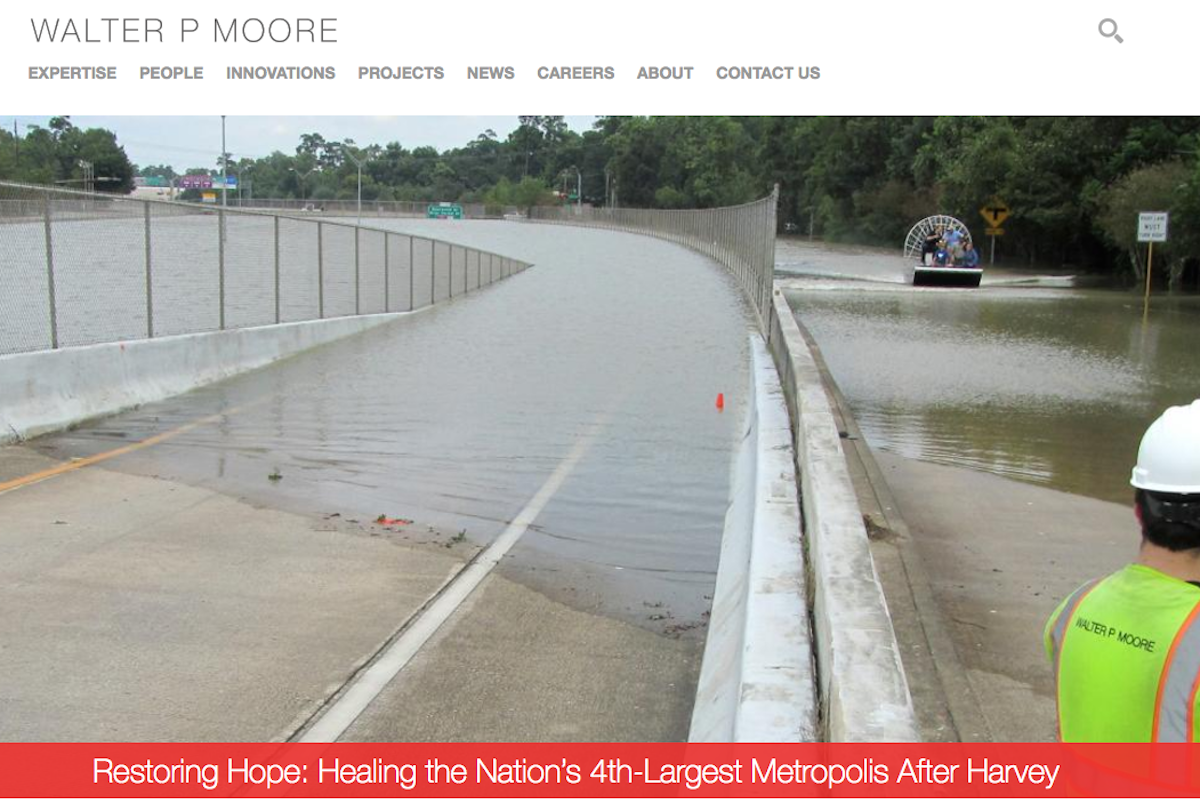by MGB2B

While they have changed it as of late, the image above was the lead message on the Walter P Moore website a few days after Hurricane Harvey made landfall. Walter P Moore is an engineering firm headquartered right in Houston. When you click on the slide, it takes you to a blog post from May about building structures that are resilient in the face of hurricane season. Which was all well and good in May.
On September 1, however, it was a little alarming to see this image without a community outreach message accompanying it. Other Houston companies like ConocoPhillips and Amegy Bank had this type of message of encouragement within a few days after the storm hit.
To be fair, Walter P Moore seems to have (rightly) placed more importance on getting into the trenches and helping out the city right away than they did on their website. It was encouraging to see a new lead slide when I returned to their website.
What We Should Have Seen on the Website Right Away:

Branding after disasters – whether natural or manmade – can be precarious. (Some are downright tasteless.) But there are a few guidelines you can follow. Doing so can ensure your business is regarded as a caring, socially responsible member of the community.
Here’s a Quick Guide to Website Updates after a Natural Disaster:
- Have a Contingency Plan. Most of the time, your website won’t have any content that will offend your target audience. But when a disaster happens, that can change in a second. Make sure someone in your organization is in charge of reviewing dynamic site content regularly. This comes in particularly handy after natural disasters or major world events. This person should know your brand and business well and have direct access to your website so they can make edits. The key is to have an alternate person in charge in case Person A is unable to update your site.
- Make Sure Your Website Can Be Managed by Your Staff. If you’re not already using a CMS (Content Management System), you might want to change that. Using one makes it easy for you to follow Rule #1. In a pinch, you’d be able to have any (trusted) colleague go online and make changes to your site.
- Don’t Use a Disaster-Response Message to Sell. When you do post something on your site responding to a hurricane, a terrorist attack, or any type of disaster, make sure your message cannot be seen in any way as selling your products or services. This may seem like common sense, but a lot of brands ignore the rule. Don’t be one of them.
- Be Sensitive to the Emotional Needs of Your Community. This should go without saying. If you can’t come up with something on your own, find a good writer to carefully craft the message you want to appear on your site. Let the community know that you are with them. This can take the form of a letter from the CEO or a simple visual that links to a blog talking about the disaster aftermath and the need for help. If it’s not your community and you want to help out, you can include a donation button on your website, so that anyone who visits can help out through your site. There are many options available.
Walter P Moore redeemed itself with both its actions and its new lead website story. Your brand can be a step ahead of the game by following the advice above. Instead of responding, just be ready for whatever might come down the pike. These days, it could very well be anything.
In the meantime, let’s send out our heartfelt support to the communities affected by both Harvey and Irma in the past few weeks. They are going to need all the help they can get.
Continue Reading
by MGB2B

The Myth: Only B2C Brands Can Benefit From Working With Influencers.
The Truth: Influencers May Play a Different Role, But Can Be Equally Valuable for B2B Brands.
When someone says “influencer,” perhaps you the imagine a Kardashian promoting weight-loss tea on Instagram. This type of strategy surely can’t work for your B2B brand, can it? As it turns out, there are a number of strategies to help your business identify proper influencers (even if they aren’t Kardashians) and have them play a beneficial role in advocating for your company. Here’s a quick guide:
What Are Influencers for B2B Brands? And Why Work With Them?
Let’s start out with a definition we can all agree on. An influencer is, simply put, a person who has the power to influence many people via social or traditional media. This comprises everything from bloggers, vloggers, and Instagrammers, to industry analysts, thought leaders, and writers for trade publications.
The relationship between influencer and brand is symbiotic. It’s easy to see why you’d want to work with one: you have a product or service you want to market; influencers have a built-in audience. But influencers have their own brand they need to uphold – themselves. A large part of this image relies upon fresh, relevant content that keeps their followers interested and informed. From simple product mentions to expert interviews, with the right strategy, your brand could be a source of reliable, non-advertorial content that influencers value. Or they may produce it themselves based on what they learn from you. It varies from influencer to influencer.
Keep Your Niche In Mind.
Consider working with micro-influencers, who may not be the most popular, but hold the most knowledge, expertise, and influence within an industry or particular vertical. These are individuals who have probably gained their influence organically over time. They value their audiences enough that they want to provide them with good information. And because of that, they are seen as trustworthy. Your company can work with thought leaders, industry analysts, bloggers, or writers for trade publications. It’s important to note that these micro-influencers are authentic advocates. And while their audience may not be huge, you can bet it’s very interested in the niche. So you’re getting quality over quantity.
What Your Influencer Wants.
Not everyone is motivated by the same incentive. Some will operate for as little as $50 and a gift card. Others get paid in the millions. And everything in between. This person has valuable industry insights. No matter what you offer to pay them, they will not promote a product or service they don’t believe in. After all, they have a reputation and industry cred that they’ve built up over the years. The key is to let them know how you’ll contribute to that credibility and reputation in a positive way. What’s even more important is that you do your due diligence before partnering with someone.
Think Long Term.
Remember that working with an influencer is about building a relationship, which takes time. This is not a one-time transaction. B2B brands usually work with much more complex products, so your influencer needs to have a full understanding of your industry and your products before they begin advocating for you. Before you enter into a partnership, get to know the influencer as well as you can. Invest some time – it will be worth it. And above all, makes sure you communicate openly and authentically, every step of the way.
There are a multitude of ways you can work with an influencer, whether you have them share or collaborate on content, speak at your event, or blog about your product. When you work with micro-influencers within your niche and approach them with a long-term relationship in mind, you set your company up for success.
Continue Reading
by MGB2B
 Last week, we discussed whether corporate social responsibility is necessary for B2B brands and the many benefits your business can gain from it. Attracting better talent. Lowering costs. Improving your reputation. Even increasing profits. It’s clear that social involvement is crucial for B2B brands today. Follow these tips for B2B social responsibility to get your program started right:
Last week, we discussed whether corporate social responsibility is necessary for B2B brands and the many benefits your business can gain from it. Attracting better talent. Lowering costs. Improving your reputation. Even increasing profits. It’s clear that social involvement is crucial for B2B brands today. Follow these tips for B2B social responsibility to get your program started right:
Consider What Your Prospects Care About
Your marketing department may have some of the best information when it comes to the preferences of your prospects. There are many directions you can go when it comes to supporting social causes. You can center an entire campaign around a specific issue, or you can incorporate charitable actions into your business in other ways. You have to decide as a company what is the best approach to take. But it can only help to take into consideration what prospects value most. Find out what they care about, and if it aligns with your company goals, you’ve found your social responsibility focus.
Raise Awareness
To build your reputation, it takes more than making your current clients aware of your social efforts. Who else has stake in your company? Involving the community, shareholders, government, and other organizations can be an essential part of the process. It’s also important to play an active role in your local community. While thinking large-scale in your social efforts is good, it never hurts to participate in local events and support the community where your business resides. For small businesses, this may be the full extent of your CSR efforts, but the community help make your message go further.
Spread the Word on Social Media
Promoting your community involvement or charitable efforts on social media is key. If a regional office of your company is participating in community events, snap some photos and upload them to your social media channels. People will like to see your involvement and support in these local activities. And – even more importantly – it draws attention to the organization you’re helping.
Dedicate A Page On Your Website
While larger companies like Google can devote entire websites to their CSR efforts, you may want to consider a single landing page on your website. Many companies dedicate a page on their websites to “Community Involvement,” where they list their corporate social responsibility efforts or the organizations they partner with. This is an easy way to showcase your efforts. You can house your CSR stories here and drive people to the page through SEO and social media distribution.
Some may think corporate social responsibility is irrelevant for B2B brands. The truth is, prospects today want to work with companies that not only make good things, but do good things. What kind of good things has your B2B brand been doing lately?
Continue Reading



